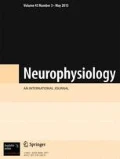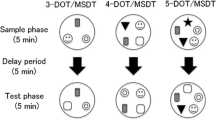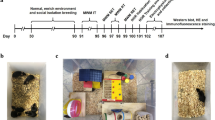The aim of our study was to evaluate the effects of spatial learning in the hidden-platform water maze task on the process of social recognition in aged rats. The recognition in contacts with a new housing partner was compared before and after such spatial learning in the hidden-platform water maze, as well as in animals undergoing such spatial learning and simply swimming (in the water maze with no platform). The aged rats after spatial learning experience showed a significantly higher social recognition index than before spatial learning exercise and also in comparison with the aged rats possessing only swimming experience. These results indicate that spatial learning may noticeably improve the social recognition abilities in aged rats.
Similar content being viewed by others
References
J. R. Epp, M. D. Spritzer, and L. A. Galea, “Hippocampusdependent learning promotes survival of new neurons in the dentate gyrus at a specific time during cell maturation,” Neuroscience, 149, No. 2, 273–285 (2007).
H. M. Sisti, A. L. Glass, and T. J. Shors, “Neurogenesis and the spacing effect: learning over time enhances memory and the survival of new neurons,” Learn. Mem., 14, No. 5, 368–375 (2007).
N. M. Conejo, H. Gonzalez-Pardo, G. Vallejo, and J. L. Arias, “Changes in brain oxidative metabolism induced by water maze training,” Neuroscience, 145, No. 2, 403–412 (2007).
J. P. Lerch, A. P. Yiu, A. Martinez-Canabal, et al., “Maze training in mice induces MRI-detectable brain shape changes specific to the type of learning,” Neuroimage, 54, No. 3, 2086–2095 (2011).
F. Gуmez-Pinilla, V. So, and J. P. Kesslak, “Spatial learning and physical activity contribute to the induction of fibroblast growth factor: neural substrates for increased cognition associated with exercise,” Neuroscience, 85, No. 1, 53–61 (1998).
V. Ramírez-Amaya, M. L. Escobar, V. Chao, and F. Bermúdez-Rattoni, “Synaptogenesis of mossy fibers induced by spatial water maze overtraining,” Hippocampus, 9, No. 6, 631–636 (1999).
M. Engelmann, K. Ebner, R. Landgraf, and C. T. Wotjak, “Effects of Morris water maze testing on the neuroendocrine stress response and intrahypothalamic release of vasopressin and oxytocin in the rat,” Horm. Behav., 50, No. 3, 496–501 (2006).
L. J. Young, “The neurobiology of social recognition, approach, and avoidance,” Biol. Psychiat., 51, No. 1, 18–26 (2002).
J. N. Ferguson, L. J. Young, and T. R. Insel, “The neuroendocrine basis of social recognition,” Front. Neuroendocrinol., 23, No. 2, 200–224 (2002).
E. Gould, A. Beylin, P. Tanapat, et al., “Learning enhances adult neurogenesis in the hippocampal formation,” Nat. Neurosci., 2, No. 3, 260–265 (1999).
M. Sakamoto, I. Imayoshi, T. Ohtsuka, et al., “Continuous neurogenesis in the adult forebrain is required for innate olfactory responses,” Proc. Natl. Acad. Sci. USA, 108, No. 20, 8479–8484 (2011).
L. Lu, G. Bao, H. Chen, et al., “Modification of hippocampal neurogenesis and neuroplasticity by social environments,” Exp. Neurol., 183, No. 2, 600–609 (2003).
X. Guan and D. E. Dluzen, “Age-related changes of social memory/recognition in male Fischer 344 rats,” Behav. Brain Res., 61, No. 1, 87–90 (1994).
R. Morris, “Developments of a water-maze procedure for studying spatial learning in the rat,” J. Neurosci. Methods, 11, No. 1, 47–60 (1984).
D. H. Thor and W. R. Holloway, “Social memory of the male laboratory rat,” J. Comp. Physiol. Psychol., 96, 1000–1006 (1982).
M. Engelmann and M. Ludwig, “The activity of the hypothalamo-neurohypophyseal system in response to acute stressor exposure: neuroendocrine and electrophysiological observations,” Stress, 7, No. 2, 91–96 (2004).
M. Ludwig and Q. J. Pittman, “Talking back: dendritic neurotransmitter release,” Trends Neurosci., 26, No. 5, 255–261 (2003).
M. Engelmann, R. Landgraf, and C. T. Wotjak, “The hypothalamic-neurohypophyseal system regulates the hypothalamic-pituitary-adrenal axis under stress: an old concept revisited,” Front. Neuroendocrinol., 25, Nos. 3/4, 132–149 (2004).
R. Landgraf and I. D. Neumann, “Vasopressin and oxytocin release within the brain: a dynamic concept of multiple and variable modes of neuropeptide communication.,” Front. Neuroendocrinol., 25, Nos. 3/4, 150–176 (2004).
T. B. van Wimersma Greidanus and C. Maigret, “The role of limbic vasopressin and oxytocin in social recognition,” Brain Res., 713, Nos. 1/2, 153–159 (1996).
C. H. Bailey and E. R. Kandel, “Structural changes accompanying memory storage,” Annu. Rev. Physiol., 55, 397–426 (1993).
R. E. Clark and L. R. Squire, “Classical conditioning and brain systems: the role of awareness,” Science, 280, No. 5360, 77–81 (1998)
G. Riedel, J. Micheau, A. G. Lam, et al., “Reversible neural inactivation reveals hippocampal participation in several memory processes,” Nat. Neurosci., 2, No. 10, 898–905 (1999).
P. R. Solomon, E. R. Vander Schaaf, R. F. Thompson, and D. J. Weisz, “Hippocampus and trace conditioning of the rabbit’s classically conditioned nictitating membrane response,” Behav. Neurosci., 100, No. 5, 729–744 (1986).
M. B. Moser, M. Trommald, and P. Andersen, “An increase in dendritic spine density on hippocampal CA1 pyramidal cells following spatial learning in adult rats suggests the formation of new synapses,” Proc. Natl. Acad. Sci. USA, 91, No. 26, 12673–12675 (1994).
B. Leuner, J. Falduto, and T. J. Shors, “Associative memory formation increases the observation of dendritic spines in the hippocampus,” J. Neurosci., 23, No. 2, 659–665 (2003).
S. Corkin, “Lasting consequences of bilateral medial temporal lobectomy: Clinical course and experimental findings in H.M,” Semin. Neurol., 4, No. 2, 249–259 (1984).
H. Maaswinkel, A. M. Baars, W. H. Gispen, and B. M. Spruijt, “Roles of the basolateral amygdala and hippocampus in social recognition in rats,” Physiol. Behav., 60, No. 1, 55–63 (1996).
Author information
Authors and Affiliations
Corresponding author
Rights and permissions
About this article
Cite this article
Zeng, Q., Han, J., Wang, B. et al. Water Maze Spatial Learning Enhances Social Recognition Ability in Aged Rats. Neurophysiology 44, 464–469 (2012). https://doi.org/10.1007/s11062-012-9319-4
Received:
Published:
Issue Date:
DOI: https://doi.org/10.1007/s11062-012-9319-4




